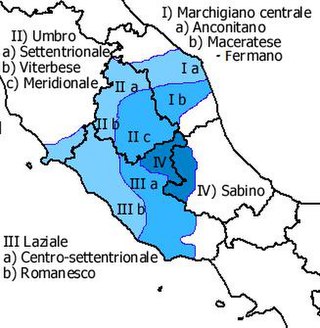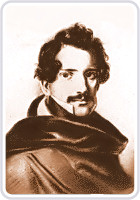

This article needs additional citations for verification. Please help improve this articlebyadding citations to reliable sources. Unsourced material may be challenged and removed.
Find sources: "Romanesco dialect" – news · newspapers · books · scholar · JSTOR (October 2007) (Learn how and when to remove this message) |
| Romanesco | |
|---|---|
| Romano | |
| Native to | Italy |
| Region | Metropolitan City of Rome Capital, Lazio |
| Latin | |
| Language codes | |
| ISO 639-3 | – |
| Glottolog | None |
| Linguasphere | 51-AAA-rab |
 | |
| This article contains IPA phonetic symbols. Without proper rendering support, you may see question marks, boxes, or other symbols instead of Unicode characters. For an introductory guide on IPA symbols, see Help:IPA. | |

Romanesco (Italian pronunciation: [romaˈnesko]) is one of the central Italian dialects spoken in the Metropolitan City of Rome Capital, especially in the core city. It is linguistically close to Tuscan and Standard Italian, with some notable differences from these two. Rich in vivid expressions and sayings, Romanesco is used in a typical diglossic setting, mainly for informal/colloquial communication, with code-switching and translanguaging with the standard language.

The medieval Roman dialect belonged to the southern family of Italian dialects, and was thus much closer to the Neapolitan language than to the Florentine.[1][2] The 11th-century Saint Clement and Sisinnius inscription already has Romanesco features. A typical example of Romanesco of that period is Vita di Cola di Rienzo [it] ("Life of Cola di Rienzo"), written by an anonymous Roman during the 14th century.[1] Starting with the 16th century, the Roman dialect underwent an increasingly stronger influence from the Tuscan dialect (from which modern Italian derives) starting with the reigns of the two Medici popes (Leo X and Clement VII) and with the Sack of Rome in 1527, two events which provoked a large immigration from Tuscany.[3][4] Therefore, current Romanesco has grammar and roots that are rather different from other dialects in Central Italy.[4]
The path towards a progressive Tuscanization of the dialect can be observed in the works of the major Romanesco writers and poets of the past two centuries: Giuseppe Gioachino Belli (1791–1863), whose sonetti romaneschi represent the most important work in this dialect and an eternal monument to 19th century Roman people; Cesare Pascarella (1858–1940); Giggi Zanazzo (1860–1911); and Carlo Alberto Salustri (1871–1950), nicknamed Trilussa.
Before Rome became the capital city of Italy, Romanesco was spoken only inside the walls of the city, while the little towns surrounding Rome had their own dialects. Nowadays, these dialects have been replaced with a variant of Romanesco, which therefore is now spoken in an area larger than the original one. It slightly pervades the everyday language of most of the immigrants who live in the large city.[citation needed]

Romanesco pronunciation and spelling differs from Standard Italian in these cases:
Ma nun c'è lingua come la romana |
But there is no language like the Roman one |
| —G. G. Belli, "Le lingue der monno" [Languages of the world][7] |
Today, Romanesco is generally considered more of a regional idiom than a true language. Classical Romanesco, which reached high literature with Giuseppe Gioachino Belli, has disappeared.
External forces such as immigration and the dominance of Italian are playing a role in the transformation.
This section of a biography of a living person needs additional citations for verification. Please help by adding reliable sources. Contentious material about living persons that is unsourced or poorly sourced must be removed immediately from the article and its talk page, especially if potentially libelous.
Find sources: "Romanesco dialect" – news · newspapers · books · scholar · JSTOR (September 2014) (Learn how and when to remove this message) |
|
| ||||||||||||||||||||||||||||||||||||||||||||||||||
|---|---|---|---|---|---|---|---|---|---|---|---|---|---|---|---|---|---|---|---|---|---|---|---|---|---|---|---|---|---|---|---|---|---|---|---|---|---|---|---|---|---|---|---|---|---|---|---|---|---|---|
Historical linguistic minorities: Albanian, Catalan, Croatian, French, Franco-Provençal, Friulian, Germanic, Greek, Ladin, Occitan, Romani, Sardinian, Slovene, Wenzhounese | ||||||||||||||||||||||||||||||||||||||||||||||||||
|
| |||||||||||||||||||||||||||||||||||||||||||||||||
| ||||||||||||||||||||||||||||||||||||||||||||||||||
|
| |||||||||||||||||||||||||||
|---|---|---|---|---|---|---|---|---|---|---|---|---|---|---|---|---|---|---|---|---|---|---|---|---|---|---|---|
| Major branches |
| ||||||||||||||||||||||||||
| Eastern |
| ||||||||||||||||||||||||||
| Italo- Dalmatian |
| ||||||||||||||||||||||||||
| Western |
| ||||||||||||||||||||||||||
| Others |
| ||||||||||||||||||||||||||
| Reconstructed |
| ||||||||||||||||||||||||||
| |||||||||||||||||||||||||||
| Authority control databases: National |
|
|---|